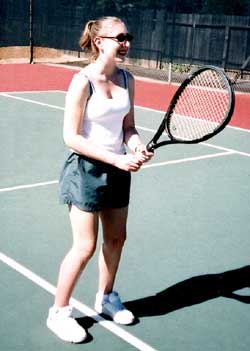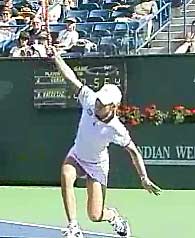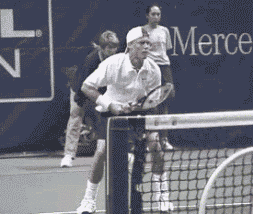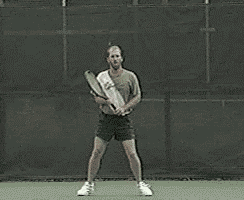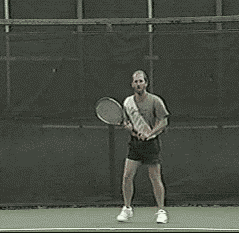
Effortless Tennis - Keys to Peak Performance
by Brent Zeller
|
|
The program I have pieced together from many different sources is based on what I have perceived to be the Keys to Peak Performance, thirteen areas that lead a player to achieving his/her potential, both on and off the court. These are the areas that we need to continue to work on our whole lives.
Thirteen Key Components
Many of these keys have been used by other teachers over the years, but many also take on new significance once competition has been removed from the learning process. The thirteen areas are:
|
|
|
These areas are the learning modules we are
working on individually and collectively. This is where the
learning process gets challenging. There is a lot to get together. The
good part is that whatever you want to learn, these keys will apply.
Each of these areas has its own list of component parts that need to be
mastered. If we needed to master only one of theses areas the difficulty
factor would be much lower, but that is not the case. Individually, each
module requires a lot of work, and when you combine all the modules, it
takes years to integrate all the different elements. Each module is
connected to all the other modules, and we play our best only when
they are all integrated. This is why getting to the point where we are
able to play consistently “in the zone,” takes a long time and a lot of
play. Excelling is easy, it just takes a long time.
Joy
|
|
For a long time I have known that if we are to be successful, it is important to enjoy what we are doing. Over the last five years I have recognized that not only must we enjoy what we are doing, but what we are doing must make us joyful. Joy is essential for peak performance. So often in competition we get into associating joy with winning. We are joyful only after we have won the point, game, set, match, or championship.
Most
people are not experiencing joy, or any other positive emotion while they
are playing. I have seen few competitors who were joyful while they were
playing, and virtually none after they have lost. What I am working on in
Effortless Tennis is to, eventually, have players be able to experience
joy as they are playing, and specifically while they are contacting the
ball. The funny thing is that, because of the premature introduction of
competition, few people are experiencing any positive emotion as they are
contacting the ball. Competition has taken much of the joy out of the
learning process and out of playing. It is time to put it back in.
Getting people to feel joy while playing changes everything. Relaxation
and performance levels improve immediately. What I see so often is people
trying so hard to focus that it looks like a great strain. We’ve all been
told over and over that we must be serious to excel, that if we are having
too much fun we are goofing off. The thing we must be is focused, not
serious. There is a huge difference.
Not surprisingly, putting joy at the top of the peak performance list has
brought a lot of joy to the program. People are having much more fun, even
when they are not doing well, because I remind them that they are still
learning the game, and they can’t expect to hit the ball perfectly every
time. When I see people getting serious and upset with themselves I ask
how their joy factor is. This is usually enough to get them to lighten up
and
have a better mental attitude when the next ball comes. For some people
however, asking them about their joy factor makes them more uptight, but I
will playfully continue to ask them about their emotional state, until
they
are able to lighten up. Tennis is, after all, just a recreational
activity, so people shouldn’t get too upset. With no competition there is
even less reason to get upset. Long-term, joy is essential for peak
performance.
Relaxation
For many years great teachers have been emphasizing the importance of concentration and relaxation in achieving peak performance. It is a standard in mental training. Today if we watch any professional sporting event it is as if there are only 3 reasons that people fail; they were not focused, not relaxed, or both.
Teachers are always telling their students to relax but the problem is
that, if you have not mastered the skills necessary to be able to relax,
then it is impossible to relax in a competitive situation. In competition
it feels
like we’ve always got to be “on guard.” It is hard to be relaxed and on
guard at the same time. Even though everyone says that our ego and self
worth aren’t on the line when we compete, it sure seems like they are.
After the contest everyone asks, “who won?” We are supposed to win.
Relaxing sounds simple, but under pressure it is very difficult to
achieve, especially if you haven’t learned how to do it first in a
non-competitive environment.
|
|
I have been teaching the importance of relaxation for the last twenty-eight years, but it was not until I removed competition from my program that I realized the enormity of its importance, and eventually how to achieve it. This is one of the most important findings of my research. It took two or three years after removing competition from the program to finally start seeing and feeling how truly relaxed we could be and still perform at our maximum ability. To this day, 10 years after I removed competition, I am still peeling away more layers in my relaxation. It feels so good.
Because of previous experiences with prematurely getting into competition,
the vast majority of people are incredibly uptight when performing.
Without years of training where there is no competition, it is impossible
to
experience true relaxation in a competition. First we must know what
complete
relaxation feels like in a cooperative environment, because if we can’t
relax
when there is no pressure, we are not going to be able to relax when there
is
pressure.
One of the places that it is easy to see if someone is relaxed while they
are
playing is to observe their facial expressions. If someone’s mouth is
contorted, or their tongue is sticking out the side of their cheek, or all
their neck muscles are bulging, they are not relaxed. Doing any of these
things is not helping make the shot any better. This display of tightness
is
lowering performance.
Because of everyone’s past experience with competition, it takes time for
people to learn how to relax. The tricky part that I’ve found about
getting
people to relax, is that initially, when they relax, they tend to lose
concentration. It is as if it is impossible to concentrate and relax
simultaneously. Fortunately this is not the case; it is a matter of
acquiring
the skill of doing both simultaneously. It seems that people associate
relaxing with not having to focus; this is one kind of relaxation, but as
in
meditation, the concentration we are talking about is a very relaxed state
of
attention. We are focused yet relaxed. There is a fine balancing line
between
focusing and relaxing.
One of the interesting side effects of relaxation is that players are able
to
hit the ball with tremendous power, while being relaxed. They don’t have
to
tighten up and “muscle” the ball to get power. With good preparation and
mechanics it is possible to hit powerful shots that feel “effortless.” We
are using physics to hit the ball. When an object (the ball, weighing a
few
ounces) is moving toward us at x miles an hour and we put our whole body
weight behind it, contacting it at the ideal contact point, at the ideal
moment in time, that ball will fly back over the net with great pace. It
feels like we have done nothing, yet the power is there. Effortless power.
Concentration
Concentration is the ability to stay focused on what we need to focus on, no matter what is happening around us. Two of the clearest examples that demonstrate concentration come from observing cats and dogs. If we watch a cat as it tries to get a bird or a mouse, we see its focus is absolute. Nothing will distract it. Likewise with a dog that likes to chase balls. If it is waiting for someone to throw the ball, its complete attention is on that ball. In whatever activity we are participating in, this is the level of concentration we must attain if we are to reach our potential.
|
|
In tennis what we need to focus on is the little yellow tennis ball. No matter where it goes or what it is doing, we have to stay focused on it. Concentration is one of the hardest skills to master in tennis. Nobody can focus for us. There is no where else in our life that we have to have so much focus, on such a consistent basis, as we do on a tennis court.
Our minds
like
to wander from the past to the future, and the challenge is to learn how
to
stay focused in the present. It is the only moment we have any direct
control over. Once that ball hits off our racquet, it is gone and we can’t
do
anything about it. In tennis we develop our concentration by practicing
the
different strokes we need to master. While we are learning to master our
strokes we are simultaneously developing our ability to stay focused. Here
again, we must first be able to stay focused when there is no pressure, no
competition, before we can hope to stay focused when there is pressure.
Effortless Tennis is a great way to learn how to improve our concentration
and stay focused in the present. After we hit the ball we have between one
and four seconds to get ready for the next shot, there is no time to
ponder
what we just did, or what might happen next. We must stay focused on the
ball
to know exactly where it is going to land. This is one of the great
aspects
of the Effortless program. Learning the skill to be able to hit our shot
and
immediately refocus on the ball as it travels over the net. It is so
easy
to be analyzing our last shot, whether it felt great or horrible, but in
that
second or two that we are analyzing, we are not focused on the ball, so we
don’t see what is happening.
Once a shot leaves our strings, we can’t do anything about it.
Only
in the present do we have any control over our shot. Even without
competition, developing high levels of concentration is a long-term
project.
To stay focused on the ball as we run all over the court, and then have
only
a few seconds to get ready for the next shot, and the next, and the next, is a great challenge. We need to achieve a meditative state
while
we run around the court. Effortless Tennis is a moving meditation. 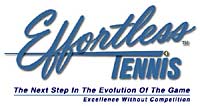
Patience, Perseverance, & Self-motivation
These three keys on the Peak Performance list are also life skills.
They are
important in getting anywhere, no matter what we want to learn or do. All
three are challenging to acquire, but essential to achieving peak
performance. The dictionary gives the definition of patience as, “an
ability
to suppress annoyance when confronted with delay.” Everyone has
experienced
this annoyance with delay on many occasions. Unfortunately, it seems that
we
have been taught to want everything now, no waiting—instant gratification.
Too bad it doesn’t work that way very often. Patience isn’t just a virtue,
it is a key to success. Some times things take longer to develop than we
want
them to, and we must have the patience to persevere.
Perseverance is the ability to stay with something, even when things don’t
seem to be going the way that we want. If we are to achieve high level
goals
though, we have to keep going even when we may want to stop. In a
competitive
based system, if someone is experiencing repeated failure, it is much
easier
to get discouraged and give up. One of the major discoveries that I have
found from a non-competitive learning system is that there are these
natural
learning plateaus that everyone goes through, and that a competitive
system
does not allow us to progress through these plateaus at our own
‘individual’
pace. In a competitive system we must win—now. People are weeded out
before
they have a chance to develop, before they work through these plateaus.
When we first start an activity we can feel like we are progressing more
quickly, but then we get into that first learning plateau around the six
month mark, and it doesn’t seem like we are improving as rapidly. When we
first start playing, we do improve faster, but the longer we play, the
longer
it takes to see additional improvement. If people can stay with the game,
then they will see that next jump in improvement at around the one year
mark,
for some it may take a little longer. After the one year mark, it will
be
approximately another year until someone will feel that next level of
integration. No matter how much we work, it will still take about this
time.
The more we practice the better, but some of our improvement is just in
the
length of time we are involved with an activity; there is a lot of
information to integrate and it can’t be rushed. Many people have trouble
persevering through this first year, they feel like they want to see more
improvement faster, but this is not how it works. Learning is cumulative.
Everything we do eventually adds up.
|
|
The next learning plateau is where we lose most people. That plateau
occurs
somewhere after the second year and can last anywhere from one to three
years, depending on many different factors, mainly how much someone
practices. If however, someone can keep with the game through this period,
she/he will, after this next leap occurs, be able to feel confident with
her/his skills, and enjoy her/his tennis for the rest of their lives. For
someone like me who has been playing for so many years, the plateaus are a
minimum of five years apart. I feel I am still improving, and every once
in a
while, I feel things go to another level. Mastery can occur sometime after
the 10 year mark.
The premature emphasis on competition doesn’t allow us to go through this
natural learning progression. It seems like there are periods where we
aren’t
improving, but what is happening is that we are integrating the new
information we have been learning into our cellular memory. If we don’t
continue along the plateau we will never get to the next leap. This is
where
perseverance comes in. People can’t see and feel the improvement while
they
are on a plateau, but the work they are doing is essential in order to go
to
the next level. Once people understand the phenomenon of learning
plateaus,
it is easier to learn perseverance.
The last of this set of learning modules, and from what I have seen, the
most
difficult for most people, is self-motivation. It is the key that
separates
success from failure. People will help encourage us along our journey, but
in
the end, if we wish to succeed, it is up to each of us to motivate
ourselves.
No one can force us to do anything. We have to be the ones to get
ourselves
to put in the time and do the practice. Excellence does not happen through
luck or osmosis, it happens through self-motivation. Self-motivation is
one
of the areas I stress with young people. If I can help them
understand
the importance of self-motivation and how to get started with it, they
will
do fine in life.
Although still a formidable challenge no matter what, developing all three
of
these areas is made easier in a non-competitive environment. Since there
is
less pressure, people can take their time with the learning process, stay
with the process when things don’t seem to be improving, develop the
self-motivation to get out and do the work necessary to improve, and not
get
as easily discouraged.
Cellular Memory
I used to call this key, muscle memory, but decided that cellular memory is the better term. Cellular memory indicates that something is even more deeply ingrained into our being. We humans have two levels to us: on one level we are these amazingly complex beings who have the potential to speak many languages, produce great inventions and create wondrous works of art; on another level however, we are incredibly simple beings. Whatever we repeat over and over, patterns into our cells. This is much like a computer where whatever we put into it is what comes back out. In tennis, every time we swing the racquet and move our body, it leaves an imprint of that action in our cells. It is a chemical reaction that is taking place in our brain and body. Different chemicals react in different combinations to get our muscles to move. Every time that action is repeated it reinforces that chemical imprint. After a certain amount of repetition that action becomes a habit that will repeat automatically. Our body starts doing the movement for us; we don’t have to think about it any more, it just happens. This is why it is so important, from the beginning of our involvement in any activity, to program efficient movements into our cellular memory. Once a habit is formed, it is difficult to make changes and adjustments, because now it is part of our cells; the learning process is made significantly harder. As all of us have found out, unlearning something is much harder than learning it right from the start.
|
|
A vast majority of the people I have worked with, mostly the adults, have
had
problems with what they had ingrained into their cellular memories; these
memories were limiting their development. Cellular memory has mental and emotional components. If
someone
experiences anxiety, uncertainty, or fear when they are playing, that
reaction is also recorded in their cellular memory. If these emotional
reactions are repeated during subsequent play, under similar
circumstances,
eventually that same emotional reaction is triggered automatically. It is
difficult to hit good shots when we are anxious or fearful, especially
when
that response is happening without our control. Each time another
situation
comes up where this response happens, it gets burned more deeply into the
cellular memory. After a while people get uptight just thinking about a
potential situation like the ones that have negatively affected them
before.
This then leads to avoidance of these type of situations.
Most teachers and students do not understand the overwhelming importance
of
cellular memory in the learning process. Teaching pros feel that it is ok
to
let players swing any way they want to, any way that feels natural. I do
not
wish to stifle anyone’s individual creativity, but from what I have seen,
when players have little time to react, they make up movements that are
more
desperation, than natural. Once these movements are repeated and patterned
in, they are part of us, and they will come out under pressure. Teaching
efficient technique is essential to peak performance.
Reprogramming old habits is difficult, if not impossible to do in
competition
because the need to win is paramount. We can learn how to redo less than
efficient old habits only in a cooperative learning environment. People
with
mild to severe learning problems can begin to change to the point where
they
are able to start learning much more efficiently, and begin making leaps
in
their development. The non-competitive system allows us to be able to
change
our cellular memory, both physically, mentally, and emotionally. We need
to
start this approach from our earliest days of learning so that these
negative
responses, which I have experienced frequently myself, and I have seen in
most adults, can be prevented from happening to our children.
The good news is that just as bad, or as I like to say “less than optimal”
habits are hard to change, so are good ones. We have the ability to
ingrain
whatever we want. If we pattern efficient movements and positive emotions
into our cellular memory from the very beginning, they will be there when
we have no time to think, and we will react with what works.
Look for part 2 of Brent Zeller's "Effortless Tennis - Keys to Peak Performance" in an upcoming issue of TennisONE.
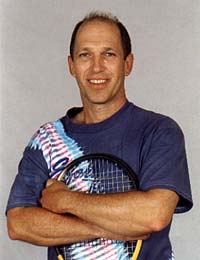 Brent
Zeller has been involved in sports for over 40 years. He’s been playing
tennis for 34 years and played tournament tennis for 18 years.
Brent
Zeller has been involved in sports for over 40 years. He’s been playing
tennis for 34 years and played tournament tennis for 18 years.
Brent began teaching in 1974 and joined the USPTA in 1975. He has been teaching in Marin since 1985. Brent has an extensive background in psychology, philosophy, and learning theory.
His evolutionary non-competitive learning system is the only one of
its kind.
www.effortlesstennis.com
To contact us, please email to: webmaster@tennisone.com
TennisONE is a registered trademark of TennisONE and SportsWeb ONE; Copyright 1995. All rights reserved.

